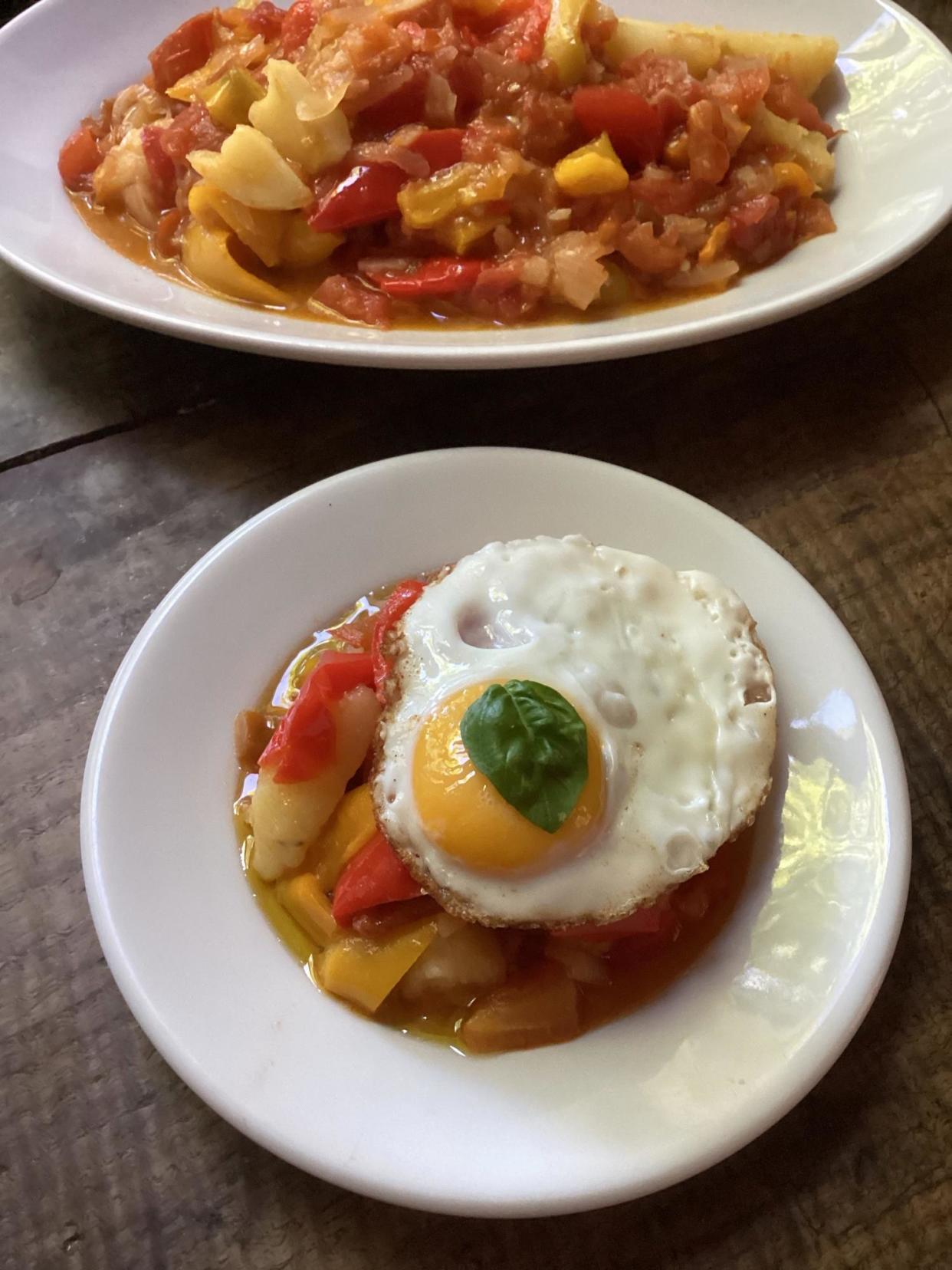Rachel Roddy’s recipe for ciambotta, or braised peppers, tomatoes and potatoes

As I’ve mentioned before, our cooker is a 1972 GasFire Cucina 800. It’s the four-burner version of the five-burner model pictured in Sophia Loren’s book, In the Kitchen with Love, published in 1972, which just happens to be the year I was born, meaning that Sophia and I, our cookers, cooking and books are inextricably linked. However, her larger model had a different arrangement of burners, as well as a protective lip for a thermostat, while mine has a full hinged lid, which protects the wall; being white, it is also a canvas for splatters, meaning Sophia and I are not linked in wiping.
Tomato is the worst, and the best, especially when the sauce is simmering nicely: mostly steady, but every now and then erupting into a burp of a bubble that splatters like a crime scene waiting for pattern analysis. Today, there were also peppers and potatoes in what can only be described as a staggered recipe that demands the lid is on and off, causing fluctuating temperatures that invite splatters. It is worth it, though, for this almost velvety, summer braise, and also because I suggest making a double quantity, half to go with pasta, and the rest with fried eggs or slices of feta.
Depending on where you are in southern Italy, this sort of improvised dish of summer vegetables (tomatoes, peppers, aubergines, courgettes) might be called ciambotta, cianfotta, ciambrotta or giambotta, all of which are suitably onomatopoeic. This version is inspired by a tomato, pepper, onion and potato ciambottella I ate in Avellino in Campania.
If you are using fresh tomatoes, you want 1kg of whatever variety (or mix of varieties) seems the tastiest. If they are small cherry or date tomatoes, simply quarter them. Cover larger tomatoes with boiling water for two minutes, then drain and cover with cold water, at which point the skins should pull away easily; you can then roughly chop the flesh. If you are using three tins of plum tomatoes, taste first and, if you like the flavour of the juice, keep it, otherwise drain it away and crush the tomatoes with your hands or a potato masher.
Ciambotta – braised peppers, tomatoes and potatoes (for two meals, with pasta and with eggs or cheese)
Serves 4
1kg ripe tomatoes (a mix of varieties, if you wish), or 3 x 400g tins plum tomatoes
6-8 tsp olive oil
2 large onions, peeled and cut into thin half-moons
2 red peppers, stalks, pith and seeds discarded, flesh cut into thick strips
2 yellow peppers, stalks, pith and seeds discarded, flesh cut into thick strips
Salt and black pepper
2 large potatoes, peeled and cut into wedges
2 garlic cloves, peeled and left whole
1 small red chilli, or a pinch of chilli flakes, to taste
1 small bunch basil, leaves picked (optional)
To serve
1st meal: 500g fusilli
2nd meal: fried or poached eggs or slices of feta
If you have small cherry or date tomatoes, simply quarter them. Otherwise, cover larger tomatoes with boiling water for two minutes, then drain and put into cold water, at which point the skins should pull away easily. Roughly chop the flesh. (Or use tinned tomatoes, drained, if you prefer.)
In a large saute pan or casserole with a lid, warm the olive oil with the onion and peppers, season with a little salt and cook, stirring, for five minutes. Cover the pan and cook for 10 minutes, in which time the vegetables will soften and collapse a bit. Add the tomatoes, potatoes, garlic, chilli and another pinch of salt, cover again and cook for 30 minutes, until the potatoes are tender. Uncover and cook for a final five or 10 minutes. If at any point the pan seems dry, add a bit of water; if it seems too watery, carry on cooking. The end result should be soft and saucy. Season to taste and stir.
Divide the contents of the pan into two parts, one a bit bigger than the other. While you boil 400-500g of fusilli in salted water, gently reheat the smaller portion, using the back of a wooden spoon to break up any larger pieces, and add a handful of torn basil and a few red chilli flakes, if you want. Add the cooked pasta to the pan, along with some of the pasta cooking water to loosen, if you think it needs it.
Now that the weather is warm, it is a good idea to keep the rest of the sauce in the fridge until you are ready to use it. Reheat it gently, rip in add a handful of basil and serve topped with fried or poached eggs, or a thick slice of feta.

